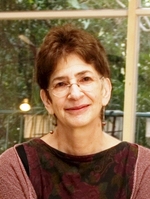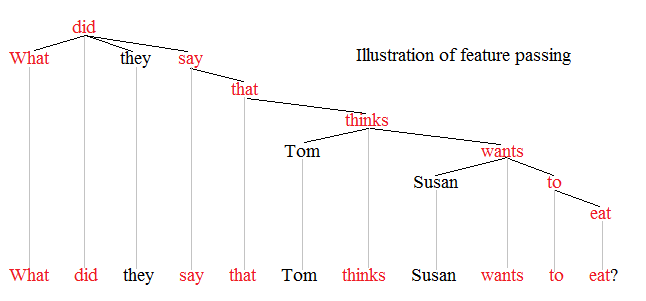|
Operator (linguistics)
In generative grammar, the technical term operator denotes a type of expression that enters into an a-bar movement dependency.Chomsky, Noam. (1981) Lectures on Government and Binding, Foris, Dordrecht.Haegeman, Liliane (1994) Introduction to Government and Binding Theory. Blackwell.Koopman, H., & Sportiche, D. (1982). Variables and the Bijection Principle. ''The Linguistic Review, 2'', 139-60. One often says that the operator "binds a variable". Cinque, Guglielmo (1991) Types of A-Bar Dependencies. MIT Press. Operators are often determiners, such as interrogatives ('which', 'who', 'when', etc.), or quantifiers ('every', 'some', 'most', 'no'), but adverbs such as sentential negation ('not') have also been treated as operators.Zanuttini, R. (1997) Negation and Clausal Structure: A Comparative Study of Romance Languages, Oxford University Press. It is also common within generative grammar to hypothesise phonetically empty operators whenever a clause type or construction exhibits sympt ... [...More Info...] [...Related Items...] OR: [Wikipedia] [Google] [Baidu] |
Generative Grammar
Generative grammar, or generativism , is a linguistic theory that regards linguistics as the study of a hypothesised innate grammatical structure. It is a biological or biologistic modification of earlier structuralist theories of linguistics, deriving ultimately from glossematics. Generative grammar considers grammar as a system of rules that generates exactly those combinations of words that form grammatical sentences in a given language. It is a system of explicit rules that may apply repeatedly to generate an indefinite number of sentences which can be as long as one wants them to be. The difference from structural and functional models is that the object is base-generated within the verb phrase in generative grammar. This purportedly cognitive structure is thought of as being a part of a universal grammar, a syntactic structure which is caused by a genetic mutation in humans. Generativists have created numerous theories to make the NP VP (NP) analysis work in natural la ... [...More Info...] [...Related Items...] OR: [Wikipedia] [Google] [Baidu] |
Wh-movement
In linguistics, wh-movement (also known as wh-fronting, wh-extraction, or wh-raising) is the formation of syntactic dependencies involving interrogative words. An example in English is the dependency formed between ''what'' and the object position of ''doing'' in "What are you doing?" Interrogative forms are sometimes known within English linguistics as '' wh-words'', such as ''what, when, where, who'', and ''why'', but also include other interrogative words, such as ''how''. This dependency has been used as a diagnostic tool in syntactic studies as it can be observed to interact with other grammatical constraints. In languages with wh- movement, sentences or clauses with a wh-word show a non-canonical word order that places the wh-word (or phrase containing the wh-word) at or near the front of the sentence or clause ("''Who'' are you thinking about?") instead of the canonical position later in the sentence ("I am thinking about ''you''"). Leaving the wh-word in its canonical positi ... [...More Info...] [...Related Items...] OR: [Wikipedia] [Google] [Baidu] |
Topic Marker
A topic marker is a grammatical particle used to mark the topic of a sentence. It is found in Japanese, Korean, Quechua, Ryukyuan, Imonda and, to a limited extent, Classical Chinese. It often overlaps with the subject of a sentence, causing confusion for learners, as most other languages lack it. It differs from a subject in that it puts more emphasis on the item and can be used with words in other roles as well. Korean: 은/는 The topic marker is one of many Korean particles. It comes in two varieties based on its phonetic environment: 은 (''eun'') is used after words that end in a consonant, and 는 (''neun'') is used after words that end in a vowel. Example In the following example, "school" () is the subject, and it is marked as the topic. Japanese: は The topic marker is one of many Japanese particles. It is written with the hiragana は, which is normally pronounced ''ha'', but when used as a particle is pronounced ''wa''. If what is to be the topic would have ha ... [...More Info...] [...Related Items...] OR: [Wikipedia] [Google] [Baidu] |
Complementizer
In linguistics (especially generative grammar), complementizer or complementiser (glossing abbreviation: ) is a functional category (part of speech) that includes those words that can be used to turn a clause into the subject or object of a sentence. For example, the word ''that'' may be called a complementizer in English sentences like ''Mary believes that it is raining''. The concept of complementizers is specific to certain modern grammatical theories; in traditional grammar, such words are normally considered conjunctions. The standard abbreviation for ''complementizer'' is C. Category of C C as head of CP The complementizer is often held to be the syntactic head of a full clause, which is therefore often represented by the abbreviation CP (for ''complementizer phrase''). Evidence that the complementizer functions as the head of its clause includes that it is commonly the last element in a clause in head-final languages like Korean or Japanese, in which other heads follo ... [...More Info...] [...Related Items...] OR: [Wikipedia] [Google] [Baidu] |
Object (grammar)
In linguistics, an object is any of several types of arguments. In subject-prominent, nominative-accusative languages such as English, a transitive verb typically distinguishes between its subject and any of its objects, which can include but are not limited to direct objects, indirect objects, and arguments of adpositions ( prepositions or postpositions); the latter are more accurately termed ''oblique arguments'', thus including other arguments not covered by core grammatical roles, such as those governed by case morphology (as in languages such as Latin) or relational nouns (as is typical for members of the Mesoamerican Linguistic Area). In ergative-absolutive languages, for example most Australian Aboriginal languages, the term "subject" is ambiguous, and thus the term "agent" is often used instead to contrast with "object", such that basic word order is often spoken of in terms such as Agent-Object-Verb (AOV) instead of Subject-Object-Verb (SOV). Topic-prominent language ... [...More Info...] [...Related Items...] OR: [Wikipedia] [Google] [Baidu] |
Scope (formal Semantics)
In formal semantics, the scope of a semantic operator is the semantic object to which it applies. For instance, in the sentence "''Paulina doesn't drink beer but she does drink wine''," the proposition that Paulina drinks beer occurs within the scope of negation, but the proposition that Paulina drinks wine does not. Scope can be thought of as the semantic order of operations. One of the major concerns of research in formal semantics is the relationship between operators' syntactic positions and their semantic scope. This relationship is not transparent, since the scope of an operator need not directly correspond to its surface position and a single surface form can be semantically ambiguous between different scope construals. Some theories of scope posit a level of syntactic structure called logical form, in which an item's syntactic position corresponds to its semantic scope. Others theories compute scope relations in the semantics itself, using formal tools such as type shift ... [...More Info...] [...Related Items...] OR: [Wikipedia] [Google] [Baidu] |
Trace (linguistics)
Syntactic movement is the means by which some theories of syntax address discontinuities. Movement was first postulated by structuralist linguists who expressed it in terms of ''discontinuous constituents'' or ''displacement''. Some constituents appear to have been displaced from the position in which they receive important features of interpretation. The concept of movement is controversial and is associated with so-called ''transformational'' or ''derivational'' theories of syntax (such as transformational grammar, government and binding theory, minimalist program). Representational theories (such as head-driven phrase structure grammar, lexical functional grammar, construction grammar, and most dependency grammars), in contrast, reject the notion of movement and often instead address discontinuities with other mechanisms including graph reentrancies, feature passing, and type shifters. Illustration Movement is the traditional means of explaining discontinuities such as ... [...More Info...] [...Related Items...] OR: [Wikipedia] [Google] [Baidu] |
Wh-movement
In linguistics, wh-movement (also known as wh-fronting, wh-extraction, or wh-raising) is the formation of syntactic dependencies involving interrogative words. An example in English is the dependency formed between ''what'' and the object position of ''doing'' in "What are you doing?" Interrogative forms are sometimes known within English linguistics as '' wh-words'', such as ''what, when, where, who'', and ''why'', but also include other interrogative words, such as ''how''. This dependency has been used as a diagnostic tool in syntactic studies as it can be observed to interact with other grammatical constraints. In languages with wh- movement, sentences or clauses with a wh-word show a non-canonical word order that places the wh-word (or phrase containing the wh-word) at or near the front of the sentence or clause ("''Who'' are you thinking about?") instead of the canonical position later in the sentence ("I am thinking about ''you''"). Leaving the wh-word in its canonical positi ... [...More Info...] [...Related Items...] OR: [Wikipedia] [Google] [Baidu] |
Syntactic Movement
Syntactic movement is the means by which some theories of syntax address discontinuities. Movement was first postulated by structuralist linguists who expressed it in terms of ''discontinuous constituents'' or ''displacement''. Some constituents appear to have been displaced from the position in which they receive important features of interpretation. The concept of movement is controversial and is associated with so-called ''transformational'' or ''derivational'' theories of syntax (such as transformational grammar, government and binding theory, minimalist program). Representational theories (such as head-driven phrase structure grammar, lexical functional grammar, construction grammar, and most dependency grammars), in contrast, reject the notion of movement and often instead address discontinuities with other mechanisms including graph reentrancies, feature passing, and type shifters. Illustration Movement is the traditional means of explaining discontinuities such as w ... [...More Info...] [...Related Items...] OR: [Wikipedia] [Google] [Baidu] |
Phonetics
Phonetics is a branch of linguistics that studies how humans produce and perceive sounds, or in the case of sign languages, the equivalent aspects of sign. Linguists who specialize in studying the physical properties of speech are phoneticians. The field of phonetics is traditionally divided into three sub-disciplines based on the research questions involved such as how humans plan and execute movements to produce speech (articulatory phonetics), how various movements affect the properties of the resulting sound (acoustic phonetics), or how humans convert sound waves to linguistic information (auditory phonetics). Traditionally, the minimal linguistic unit of phonetics is the phone—a speech sound in a language which differs from the phonological unit of phoneme; the phoneme is an abstract categorization of phones. Phonetics deals with two aspects of human speech: production—the ways humans make sounds—and perception—the way speech is understood. The communicative modali ... [...More Info...] [...Related Items...] OR: [Wikipedia] [Google] [Baidu] |
Adverbs
An adverb is a word or an expression that generally modifies a verb, adjective, another adverb, determiner, clause, preposition, or sentence. Adverbs typically express manner, place, time, frequency, degree, level of certainty, etc., answering questions such as ''how'', ''in what way'', ''when'', ''where'', ''to what extent''. This is called the adverbial function and may be performed by single words (adverbs) or by multi-word adverbial phrases and adverbial clauses. Adverbs are traditionally regarded as one of the parts of speech. Modern linguists note that the term "adverb" has come to be used as a kind of "catch-all" category, used to classify words with various types of syntactic behavior, not necessarily having much in common except that they do not fit into any of the other available categories (noun, adjective, preposition, etc.) Functions The English word ''adverb'' derives (through French) from Latin ''adverbium'', from ''ad-'' ("to"), ''verbum'' ("word", "verb"), and t ... [...More Info...] [...Related Items...] OR: [Wikipedia] [Google] [Baidu] |




